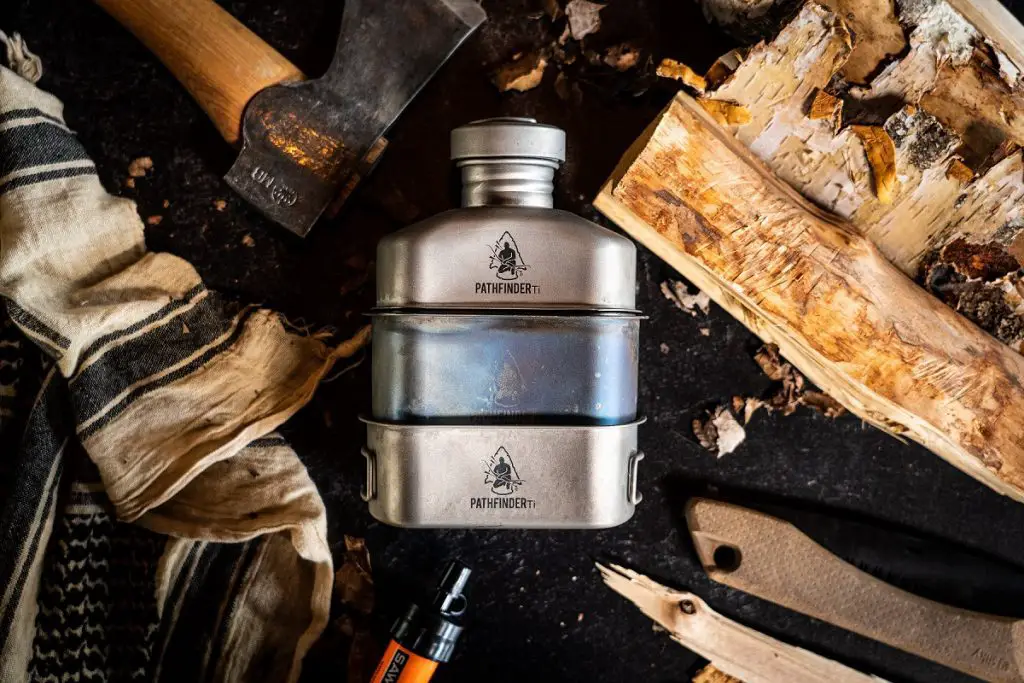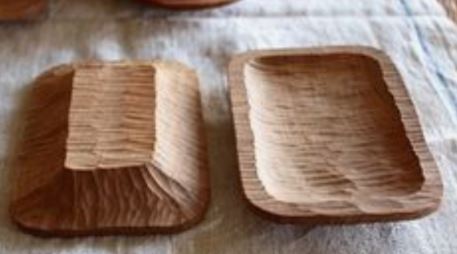A bushcraft gear list typically includes a cutting tool (knife, axe, or saw), fire starter, shelter (tarp, tent, or hammock), cooking equipment (pot, stove), water purification system, navigation tools (compass, map), cordage (paracord or rope), first aid kit, appropriate clothing, and a backpack for storage.
Heading into the wilderness with nothing but the gear on your back is an incredibly freeing experience you will remember for a lifetime. But nothing is worse than spending all day trekking to find out you forgot to pack your fire starter. I have written this article for you to use as a checklist of all the equipment you should pack while preparing for your adventure.
I have also put together this bushcraft gear list pdf to print out and check off one at a time.

Table of Contents
Bushcraft Knife
The most essential tool to pack is a knife. This can be the difference between an empty belly and a full one. They are incredibly versatile and can be used to do everything from food preparation, skinning small game, felling small trees, prepping kindling, starting fires, and general campsite repairs.
Bushcrafting knives are special tools that are shorter and thicker than most knives. This allows them to be struck on the back of the blade to cut through wood and to be used to skin small game without damaging the pelt. Selecting the best bushcraft knife for your own needs is a very personal and subjective decision.
They generally have a blade length of between 4 and 12 inches. I prefer a blade that is 3/32″ wide for fine wood carving and 5/32″ for cutting through wood.
If you have to choose between a knife, an axe, or a saw to save weight, I recommend a knife because of its versatility.
Bushcraft Axe
A high-quality bushcraft axe is one of the most useful pieces of equipment you can carry with you. They allow you to clear your campsite, build your shelter, split firewood, prepare kindling, and even prepare food. A bushcraft axe should be between 20 and 24 inches in length and weigh 2.5 pounds with a 3.5 inch cutting edge.
You will often hear of a bushcraft axe described as a camp axe, a boys axe, or a cruiser. They are smaller and lighter to make them easier to strap to your backpack. It is rare that you will be felling large trees, so having the smaller-sized axes are more versatile.
I have also found an axe to be useful for clearing trails more easily than a knife or saw.
Carving Axe
If your bushcraft axe is one the large size, you should consider packing a smaller carving axe. Carving axes are used to create all manner of new tools. Just having a carving tool means you don’t need to pack a whole range of other gear.
Some of the items I have carved over the years include:
- Spoons
- Bowls
- Plates
- Feather sticks
- Small game traps
- Tool handles
- Walking sticks
- Spears
Without a carving axe, you would need to pack and carry more equipment, especially cutlery.

Folding Saw
A folding saw is another useful but optional tool to bring on your bushcrafting journey. They are useful for felling small trees, limbing branches, building shelters, repairing tools, and crafting gear. They are extremely lightweight and can be packed in your backpack without damaging your other gear. I would go with a folding saw with a wooden handle, so that you can easily replace it if it breaks. You should consider bringing a sharpener that works on a serrated blade.
Ferro Rod
A ferro rod or any kind of firestarter is crucial to quickly get your first fire going. If you are more experienced, you can create a bow drill, but I recommend practising this at home first, so you don’t have a cold and dark first night. Ferro rods are lightweight and make lighting a fire a breeze.
I have written some more instructions about how to use a ferro rod if you haven’t used one before.
Sharpening Stone
A blunt axe is a useless axe. Keeping your gear in top condition is essential and I don’t leave home without a sharpening stone. There are also plenty of sharpeners available that will work on both axes and knives. The longer you use your axe without sharpening it the more strikes you will need to use to fell a tree or split a log. This may not be a big deal if you are only going away for a few days, but if you are planning on a multi-week trip then you will need to sharpen your axe throughout. The increased muscle fatigue by using a dull blade is significant.
It is also dangerous to use a blunt knife. You will end up using a lot more pressure to cut through game and can increase the risk of cutting yourself.
If you are packing a saw, you should consider getting a second sharpener that works on serrated blades.
First Aid Kit
Another essential item is a first aid kit. Selecting a kit that is both useful and lightweight is important. It is almost certain that you will need bandages and antiseptic cream at some point, whether from a cut from a branch or by grabbing the wrong end of your knife.
While a small cut is not a big deal in the city, it can be life-threatening if you are miles away from medical attention and a cut gets infected. It can also ruin your entire adventure if you need to hike all the way back to civilization because of a wound that starts of small but escalates quickly.
I recommend packing all of these items in your first aid kit:
- Insect Repellent
- Antiseptic Cream
- Bandages
- Water Purification Tablets
- Aspirin
- Tweezers
- Medical Tape
- Tourniquet
- Surgical Gloves
- Disinfectant
Backpack
Your backpack should be chosen for each adventure that you go on. A weekend hike requires a different backpack to a multi-week journey into the wilderness. The most important characteristics of a backpack for bushcrafting is comfort and size. You should also ensure that it is made from a durable material like nylon to avoid damage from stray branches or your axe blade rubbing.
I prefer to have a lot of external webbing and strapping that I can attach my rope, axe, and other larger tools to. This is both for easy access and to allow for more items to be stored internally.
Cooking Pot
A cooking pot can be used for everything from cooking to boiling water for safe drinking. It can also be used to carry water from a river or prepare stews and sauces. Unless you are cooking all of your food on a stick, then a pot is one of the few items you can’t carve from wood.
Sleeping Bag or Sleeping Mat
A combination of a sleeping bag, sleeping mat, or both is a great way to get a good night’s sleep. This is really up to personnel preference, but I am very particular with my sleeping conditions. Nothing will make me grumpier than having an uncomfortable sleep for multiple days. You can also pack stretchers but these take up too much room.
Sleeping bags also serve as a way to stay warm throughout the night without needing to pack bulky blankets. You should make a judgement based on the temperature at nighttime to select the correct bedding.
Clothes
Packing warm clothes is especially important if you are staying in cold climates or bushcrafting in winter. While you don’t need to worry about fashion, you do need to select durable clothes that won’t tear at the slightest stray branch. You also won’t get much opportunity to wash your clothes; I guarantee they will get sweaty and smelly. Consider how many spare, clean clothes you need – in my opinion, this generally depends on the company you will be keeping.
The number of clothes you pack depends on the length of time you intend to stay out in the wilderness. My clothes packing list includes:
- Baseball Cap
- Waterproof Jacket
- Outdoor Pants
- Hiking Boots
- Wool Pullover
- Underwear
- Socks
- Shirts
- Hat
- Belt
- Gloves
- Towel
Headlamp
Without light you are restricted to working only in daylight hours or using a fire, which isn’t very portable. A headlamp is lightweight and allows you to continue into the night. They are a lifesaver for when you need to relieve yourself at night. They are also incredibly bright and can light up your entire campsite.
Remember to pack a spare set of batteries so that you can use the torch
Compass and Map
If you have a particular destination or path to take, then having a map and compass is critical. Without GPS signal and power, modern electronics are not fail-safe enough to rely on in the wilderness. Packing a compass to use with a printed map is the next best thing. Reading a map and using a compass is one of the most useful and life-saving skills in bushcraft.
Paracord
Paracord, also known as parachute cord, is a lightweight nylon kernmantle rope that can be used for a wide range of purposes.
Packing 100-200 feet of 550 Paracord is essential to help you navigate the many problems you will experience throughout your adventure.
Some of the most common uses of paracord when bushcrafting include:
- Small game snares
- Clothesline
- Shelter building
- Bow drill cord
- Repairing equipment
Paracord is also lightweight and doesn’t take up much room in your pack – you can often tie and hang it on the outside of your backpack.
Water Bottle/Metal Canteen
Keeping a full canteen of water is lifesaving. This is both for the trek in to your campsite and for staying hydrated throughout your day-to-day work. Water should always be boiled or treated to ensure it is safe to drink which is generally done at your campsite in the morning or evening and stored in a bottle for consumption.
That brings me to the ned of this bushcraft gear list. Of course, there are dozens of other pieces of gear that you can pack to make your life easier or more enjoyable. It is just a matter of personal preference and how heavy your pack will be. I would love to hear about what other non-negotiable gear you must take on your next bushcraft adventure.
